Gasket between the tank and the toilet: types, purpose, installation features
How much irritation, headache, and inconvenience causes water that appears on the floor near the toilet! We wonder: what could be leaking in the simplest form of plumbing? We think: is this a serious breakdown or a minor violation? And when we find that the gasket between the tank and the toilet is damaged, we call the plumbers. It is so?
With our help, you can easily deal with the problem yourself. We will introduce you to the specifics of using gaskets of different configurations. Independent home craftsmen who are not afraid of any work will find here a detailed description of the procedure for laying and fixing the seals located between the toilet and the cistern.
The valuable tips we offer will help novice plumbers. The article outlines the principle of replacing the gasket, touches on technical nuances, and gives recommendations to ensure a successful result. Photos and videos are a good help to facilitate the perception of information.
The content of the article:
Briefly about household toilets
Despite the simplicity of the designs of classic household toilets, these plumbing fixtures are subject to GOST requirements (in particular, 12499, 21485, 30493).
These requirements determine both the individual structural parts and the accessories used, including the toilet gaskets that are applied when connecting the bowl to the water collection tank.
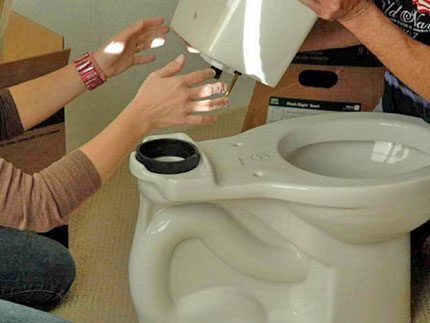
These nuances once again confirm: the quality of operation of a home plumbing fixture and the operational safety of the device directly depend on the use of only “original” parts and accessories. And the sealing gaskets between the tank and the toilet bowl are not left aside, given their fairly wide design variety.
Types of gaskets used
The purpose of the seal for its installation between the storage tank and the toilet bowl should be clear. The accessory, usually rubber or silicone, provides a seal between the two main parts of the toilet plumbing.
The shape of this mounting accessory can be:
- round;
- oval;
- trapezoidal;
- another (usually on imported devices).
It should be clarified: there are gaskets for the cistern of a home toilet, the design of which is designed exclusively for sealing the drain mechanics.
There are also seals, the role of which is to organize a soft insert between two ceramic parts.
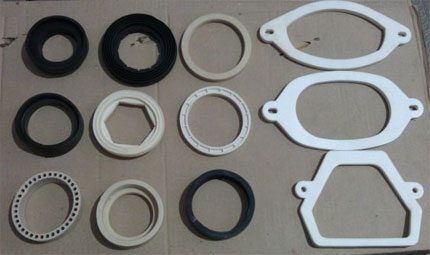
The presence of a soft insert between the mounting components additionally protects fragile faience parts from accidental damage during installation and operation. The type and shape of the seal is determined toilet size, between the tank and the bowl of which this part is placed.
Option #1 - round
In most cases, round-shaped, thickened products made on the basis of dense rubber in white or black are used as a sealing seal.
However, there are also (in sets of inexpensive models) toilet gaskets for the storage tank made of foam rubber. Such a product, which is economically justified by the manufacturer, clearly does not satisfy user needs.

In practice, foam rubber seals hold water for no more than 2-3 days of use (this should be taken into account when choosing). Ninety installations out of a hundred fail and, as a rule, force the technician to change the foam rubber to a classic rubber (silicone) seal.
Option #2 - oval
This type of gasket for home toilets under the cistern was traditionally installed on older models of plumbing fixtures. Modern designs are rarely equipped with such seals. In fact, this type of product has long been discontinued and is not used.

Meanwhile, oval products made of thick, high-quality compressed rubber showed reliable operation.True, to tightly press such seals to the coupling seat of the tank and toilet, more force was required than is required by the designs of modern gaskets.
Option #3 - trapezoidal
Trapezium is also a fairly rarely used type of gasket between the toilet bowl and the filling tank.
The trapezoidal shape of the toilet seal is characterized by a kind of negative point - for reliable sealing it requires tightening with at least three fastening screws.
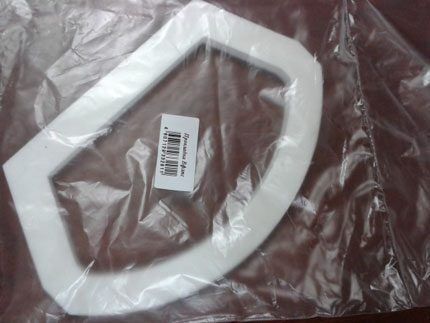
Therefore, plumbing fixtures for this type of seal usually have 3-4 fastening screws for the “fill tank - toilet bowl” tie. As a rule, two screws are located symmetrically on the two sides, and another one (two) in the center at the long (short) base of the trapezoid.
Option #4 - universal
The most commonly used gasket configuration (on toilets in the mid-price segment) is represented by a product that can be said to have a universal shape.
The outer side of such a seal is smooth and round, and the inner side is in the form of an equilateral hexagon. The working surface of the sealing ring (the area adjacent to the earthenware parts) has a wave-like shape.
This solution promotes better sealing by achieving high density even with slight tightening of the fastening bolts.

Officially, the product is called (labeled) as M60 or KK100 - depending on the diameter of the passage hole. The hexagonal internal part of such seals is designed to fit over the fastening nut of the flush mechanism, which is used in the flush cistern of modern toilet designs.
Nuances of installing seals
There are usually no special nuances for installing gaskets between the flush cistern and the toilet bowl. The exception is rare models of plumbing fixtures that are far from the standard configuration. As a rule, the seal is inserted (placed) inside the landing recess intended for it in the mating area.
After that, the drain tank is carefully placed at the installation site so that the holes for the mounting hardware on the tank and the bowl stand are aligned. It is important here not to displace the gasket from the seating area when installing the tank.
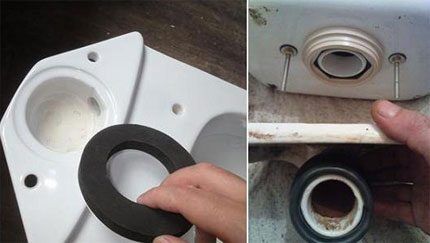
It is somewhat easier to mount the filling tank on the toilet bowl stand when gaskets of the M60 and KK100 types are used. This rubber seal fits with a slight tension onto the fastening nut of the drain mechanism. Therefore, the risk of displacement of the M60 (KK100) gasket during installation is practically reduced to zero.
Step-by-step instructions for disassembling the drain tank for repair work given here. In the article we recommend you will find many valuable recommendations.
Tank-bowl intermediate gasket
Some models of household toilets are made to connect the filling tank with the toilet bowl through an additional intermediate gasket. If it is included in the plumbing kit, the easiest way to install it is by first attaching the mounting screws to the threaded rods.

Intermediate seals traditionally have “ears” with holes through which the mounting screw rods pass. If you install the intermediate seal in place, aligned with the mounting holes, and then try to install the tank, the gasket can easily be moved out of place. Therefore, simply attaching it to the screws simplifies the installation procedure.
Screed torque
It would seem that there is nothing simpler than tightening the connection parts with screws after all the manipulations with the gaskets. Meanwhile, the fastening procedure also has its own characteristics. The nuts should be screwed onto the threads of the bolted studs evenly, by about 2-3 threads, alternately applying the action to the bolted joints.
The dismantling and reinstallation procedure is also carried out if The tank doesn't hold water. Those. if it is necessary to replace the fittings responsible for drawing and draining water from this plumbing container.
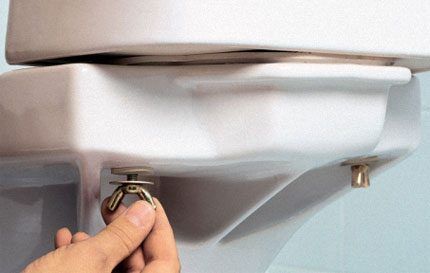
The tightening force must be calculated correctly. There is no need to retighten bolted connections when the gasket is already securely tightened. Moreover, re-tightening is not recommended for connections where polypropylene screws are used. And to ensure guaranteed reliability, it is reasonable to replace plastic fastening accessories with metal products.
Testing the installed gasket
The procedure for testing gaskets (checking the reliability of tightness) is a mandatory part of the installation. The test does not require any special metalworking procedures.
After completing the installation work, it is enough to fill the toilet tank two-thirds with water by briefly opening it shut-off valve. In this condition, the plumbing fixture should be carefully inspected in the area where the sealing rubber is located. The first test is considered passed if no obvious water leaks are detected.
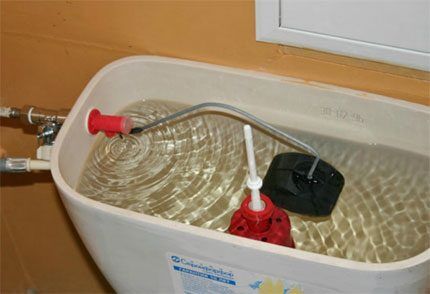
The second test will take some time - at least half an hour. It is necessary to fill the tank to the full level (the limit level of the drain mechanism) and keep it in this state (for half an hour or an hour).
Then take a piece of toilet paper and thoroughly wipe the areas of the toilet close to the area where the gasket is installed. Similar actions must be performed both on the top side and below. Is the paper dry? In this case, you can put the plumbing into operation.
If, after the second check, the toilet paper becomes damp (even partially), these symptoms indicate a poor seal. You shouldn’t rely on “maybe” here. The correct solution is to redo the installation of the filler tank and correct the installation of the sealing gasket. In this case, it is desirable to determine the causes of the leak.
It often happens that water on the floor next to the toilet is not at all the cause of its leak. This the tank “sweats”. We advise you to familiarize yourself with the reasons for the appearance of condensation on its surface and with methods for eliminating unwanted moisture.
The principle of complete tightness
Why is it necessary to ensure complete tightness of the system when installing the filler tank to the toilet bowl? The requirements are explained simply. Even a small leak leads to the formation of pockets of dampness. And dampness is the optimal environment for microbial growth.
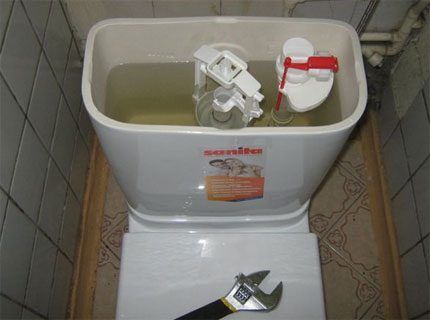
Minor (unnoticeable) water leak promotes the formation of waterstone. This substance has a negative effect on rubber - it deforms individual sections of the gasket. As a result, the operation of the device results in emergency leaks. Such accidents can occur at any time, including when home owners are away.
Finally, the presence of minor leaks and increased humidity levels inside the washroom will affect the durability of the surrounding materials. In damp conditions, the service life of even the highest quality products is reduced by half.
You will learn how to deal with a leak in the toilet itself from next article, the contents of which we recommend that you familiarize yourself with.
Conclusions and useful video on the topic
There can be several reasons for the tank leaking. The video shows how you can fix a leak by replacing old parts with new ones.
Summary of the review: such a seemingly insignificant part of the “bowl-cistern” toilet assembly, such as the sealing gasket, actually turns out to be an important element of installation.
Without installing a rubber (silicone) sealing part, operating the toilet is basically impossible. Replacing branded gaskets with home-made products also does not solve the problem. True, the quality of homemade products depends on the material and the diligence of the master..
In general, there is something to pay attention to when installing toilet plumbing.
Would you like to tell us about how you changed the sealing gasket with your own hands? Would you like to share the “tricks” of the process that only you know? Please write comments in the block below, ask questions, leave photos on the topic of the article.




Changing the gasket between the toilet and the flush cistern usually takes 10 minutes, 8 of which are for dismantling and reinstallation. I think that there is no need to call a plumber here, the operation is simple - unscrew it, throw out the old gasket, wipe it dry, install a new one (preferably silicone, they are more practical) and carefully tighten it so that the drain tank does not crack. Do not overtighten under any circumstances, you need to be careful here! If the gasket is positioned correctly, without distortions, then nothing will leak.